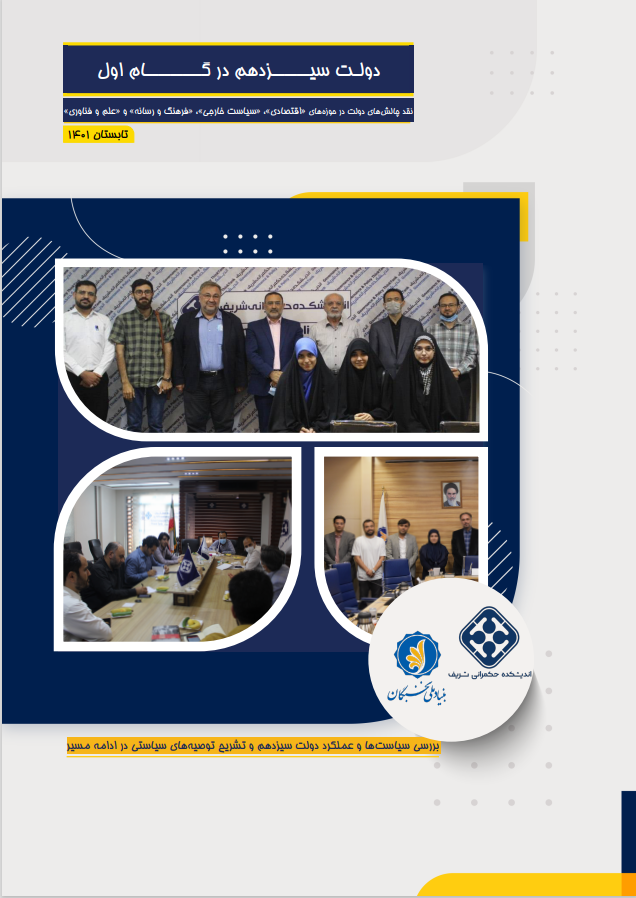governance talks report, الگوهای حکمرانی و تنظیمگری, حوزه های تخصصی, رویدادها
سؤالات محوری جلسه:۱٫۱٫۱٫ In monopolistic industries, economists view regulation as a means to exploit economies of scale from natural monopolies while reducing economic loss from market imperfections—market imperfections like high entry barriers and insufficient information. Absent regulation, those imperfections can lead to monopolistic behavior, destructive competition, scarcity, insufficient innovation, negative or positive “externalities” arising from “public goods,” and the “deadweight” economic loss that results when demand and supply curves intersect suboptimally.
۱٫۱٫۲٫ In potentially competitive industries, economists use regulation to reduce entry barriers and disseminate key market information, so that sellers and buyers act efficiently.
۱٫۲٫ Interest group perspectivesEach interest group (sometimes called “stakeholders”) views regulation differently. Consumers want protection from abuse. Shareholders want protection of profit. Lenders want protection of cash flow. New competitors want protection from the incumbent’s monopolistic practices. Environmental advocates want regulation to minimize environmental damage.
۱٫۳٫ Political perspectives۱٫۳٫۱٫ For some, regulation reduces inequities in wealth; protects the vulnerable from deceptive sales practices and price-gouging; and protects non-economic, societal values like such as worker safety, cultural treasures and endangered species.
۱٫۳٫۲٫ For others, “regulation” is a secular sin; an overuse of government power to impede individual desires.
۱٫۳٫۳٫ Political actors tend to see regulation as a double-edged sword: They like regulation when it protects; they dislike it when it obstructs.
۱٫۴٫ A concise answer۱٫۴٫۱٫ The purpose of regulation is to align private behavior with the public interest. Regulation is necessary, and necessary only, when private behavior unregulated conflicts with the public interest.
۱٫۴٫۲٫ Whether we are regulating the incumbent in a monopoly market, or competitors in a competitive market, the purpose of regulation is performance.
How do effective regulators achieve these purposes? Principles, actions and attributes۲٫۱٫ Eight principles of effective regulation۲٫۱٫۱٫ The purpose of regulation is performance. Whether we are addressing monopoly markets or competitive markets, we aim to produce high-quality service at reasonable cost. So regulators define standards of performance, create rewards for good performance and impose penalties for poor performance. Taking these steps aligns self-interest with the public interest.
۲٫۱٫۲٫ Financial success should depend on merit. Not on incumbency, not on political connections. Effective regulators define the job, then find the best entity to do that job. Regulators create and maintain a culture that forces all actors to improve.
۲٫۱٫۳٫ Economic efficiency comes first. For every decision, we must find the least-cost alternative among all feasible alternatives. We must allocate costs to those who cause the costs, and allocate benefits to those who take the risks and create the benefits. Economic efficiency comes first, allocating the gains comes second. If we are going to fight over who gets the largest slice, let us first cooperate to make the largest pie.
۲٫۱٫۴٫ There must be symmetry of risk and reward. If investors want rewards for taking risks, they must accept the losses when they fail. No bailouts.
۲٫۱٫۵٫ “Competition” is not a religion; it is a market structure. Religion is based on beliefs and prayers. We create competition not by believing and praying, but by gathering facts and applying logic. Effective competition requires many viable suppliers, many educated customers, and low barriers to entry. If those physical and economic facts do not exist, we cannot have competition, regardless of how much we believe and pray.
۲٫۱٫۶٫ Competition and regulation are not in conflict. Competition and regulation share a common purpose — to align private behavior with the public interest. Effective competition induces competitors toward efficiency, customer service, and reliability. Effective regulation does the same. Together, they induce accountability — to the consumers, investors and the public. As the economist Alfred Kahn wrote: The “central responsibility” of regulation is to find “the best possible mix, of inevitably imperfect competition and inevitably imperfect regulation.”
۲٫۱٫۷٫ Technology drives market structure: For most of the last century, customers have been served by vertically integrated monopolies—especially in energy and telecommunications. Everyone assumed that vertically integrated monopolies enjoyed economies of scale, making competition inefficient. But economies of scale change, because other things change: cost structure, technology, customer preferences and production processes. The alert regulator looks for changes in facts that challenge historic assumptions.
۲٫۱٫۸٫ Consumers are actors, not victims. Prices are not “low” or “high”; they are right or wrong. Either they reflect reasonable cost, making them efficient; or they do not reflect reasonable cost, making them inefficient. Inefficient consumption drives up demand, which drives up prices. If we want to help consumers, we should do so not by lowering their prices below cost, but instead educate and empower them to reduce costs.
۲٫۲٫ Eight attributes of effective regulators۲٫۲٫۱٫ Professional attributes
۲٫۲٫۱٫۱٫ Purposeful: The purposeful regulator first defines the public interest; then identifies how the private interests diverge from the public interest; then designs forms of regulation that align private behavior with public interest. The effective regulator does not seek “compromise,” “balance” or “consensus” among illegitimate private interests. The effective regulator instead establishes the public interest as a centripetal force—a force that disciplines private expectations and hems in private behavior.
۲٫۲٫۱٫۲٫ Decisive: The decisive regulator makes decisions required by the public interest, when the public interest requires it, regardless of discomfort felt.
۲٫۲٫۱٫۳٫ Independent: The independent regulator is independent of forces that reduce accountability, forces that attack the purpose of regulation. At minimum, a regulator must be independent of financial inducements or employment inducements. She also must be independent of arguments that are unverifiable; arguments that are emotional or rhetorical.
۲٫۲٫۱٫۴٫ Disciplined: Disciplined regulators focus on performance. Mastering the discipline of regulation requires asking the right questions. Not “What does this company want or that customer want?”, but “What actions must the company and customer take to serve the public at reasonable cost?”
۲٫۲٫۱٫۵٫ Synthesizing: Regulators deal with multiple industries (e.g., water, electricity, gas, telecommunications) and multiple professional disciplines (e.g., engineering, law, economics, finance, accounting, management), multiple policy goals (e.g., reliability, cost-effectiveness, environmental responsiveness, affordability), and multiple pressure groups (shareholders, bondholders, employees, consumers legislators, staff). Synthesizing this information is essential to success.
۲٫۲٫۱٫۶٫ Creative: Regulators should be incubators of creativity, responsible for attracting and exposing new ideas, giving the spotlight to risk-takers. They give attention to the most knowledgeable and creative people–who are not always the most prominent people. And, creativity often results in failure. The regulatory culture should encourage and accommodate experiments and failures.
۲٫۲٫۲٫ Personal attributes
۲٫۲٫۲٫۱٫ Respectful: “Human beings have deeply entrenched inclinations to delineate groups, to identify with and value members of their own group, and to adopt a cautious if not antagonistic tone to other comparable groups….[H]uman beings in every generation must attempt to deal with these proclivities and, when possible, to mute or overcome them.” Howard Gardner, Five Minds for the Future. Disrespect depends on demonizing—attaching moral significance to a policy difference. Respectful regulators recognize that no one is the sole source of truth. “[A]ccept the differences, learn to live with them, and value those who belong to other cohorts.” Gardner at 107.
۲٫۲٫۲٫۲٫ Ethical: Gardner asks: “In what kind of a world would we like to live if we knew neither our standing nor our resources in advance?” His answer: “I would like to live in a world characterized by ‘good work’: work that is excellent, ethical, and engaging.”
For Gardner, “ethics” is more than merely avoiding wrongdoing. To act ethically is “to think beyond our own self-interest and do what is right under the circumstances.” Gardner at xiv. An ethical worker “passes the hypocrisy test: she abides by the principles even when—or especially when—they go against her self-interest.” Gardner at 136.
The ethical regulator finds the common purpose whose achievement benefits all, then protect that common purpose from interference.
۲٫۳٫ Nine actions of effective regulators: Sequential decision-making۲٫۳٫۱٫ Determine the desired mix of products and services.
۲٫۳٫۲٫ Determine which products and services are natural monopolies, and which can potentially be provided through competition.
۲٫۳٫۳٫ For each category of product or service, determine the types of companies that are most likely to provide that product or service cost-effectively.
۲٫۳٫۴٫ Create criteria for competition to select the provider of monopoly services.
۲٫۳٫۵٫ Create criteria for licensing companies seeking to provide competitive services.
۲٫۳٫۶٫ For the competitive services, take all steps necessary to convert the market from its current monopoly characteristics to a competitive market.
۲٫۳٫۷٫ Arrange for any necessary sale of the incumbent’s assets to the providers of the new services.
۲٫۳٫۸٫ Identify all regulatory powers and expertise necessary to ensure success, then legislate the powers and fund the expertise, in a manner that creates long-term stability, political stature and accountability.
Obstacles to effective regulation: Three lessons from behavioral economicsEconomist Richard Thaler, and psychologists Daniel Kahneman and Amos Tversky, have inspired a generation of researchers to study the mental biases that distort decision-making. The work offers direct lessons to regulators. Here are three examples.
۳٫۱٫ Anchoring: Are decisions affected by irrelevancies?Experimenters rigged a wheel of fortune so that it always stopped on 10 or 65. Two separate groups of students were told to watch the wheel spin, write down the resulting number; then guess the percentage of African nations in the United Nations. For the group whose wheel stopped at 10, the average answer was 25%. For the group whose wheel stopped at 65. the average answer as 45%. (Kahneman, Thinking Fast and Slow at p.119.) The wheel’s number was the anchor; the anchor influenced the guess.
When a company proposes a $75 million rate increase, that number becomes the anchor. Then when the regulator allows an increase of $40 million, its declares “We saved customers $35 million.” The anchor influenced the outcome. The anchored question was: “Has the company justified a $75 million increase?” The right question is: “What should it cost to supply this service territory?”
۳٫۲٫ Halo effect: You work for a charitable organization.At a party you meet John, whom you find very amicable. You like John, so you put him on your list of possible donors. But amicability does not equal generosity. You’ve experienced the halo effect, because you viewed the relationship between amicability and generosity as “simpler and more coherent than the real thing.” Thinking Fast and Slow at 82.
Electricity is awesome, literally: Flip a switch, 500 miles away puff of smoke appears, and your light goes on. Does our awe of the utility’s mastery of technology cause us to defer to the utility’s financial desires? That is the risk of the halo effect.
۳٫۳٫ Narrow framing: A major media holding company owned 23 publications, each run by a separate executive.In a joint meeting, Thaler asked each one: If you had a chance to make an investment, one which had a 50% chance of making a profit of $2 million and 50% chance of losing $1 million, would you do it? Twenty of the 23 said no: Success would get him “a pat on the back and a bonus equal to three months income,” while failure could get him fired. The holding company CEO saw the problem: If all 23 made the investments, there would be a total gain of $11.5 million. The problem was narrow framing: The holding company’s compensation practices caused each executive to focus only on his situation rather than the total company situation. See Thaler, Misbehaving: The Making of Behavioral Economics at 188.
Are there situations in utility regulation—on the seller or the buyer side—where each individual action (or inaction) makes sense, but the combination of actions or actions does not? Narrow framing also occurs when we base a decision only on the arguments and evidence presented by opposing parties, rather than asking “What would I need to know before I formed an opinion about [this particular issue]?” Kahneman, Thinking Fast and Slow at 86.
Conclusion: How can we build regulatory institutions and practices to serve regulation’s purposes?Our regulatory agencies must be independent, expert and professional. They must not be susceptible to persuasion by any means other than facts and logic. A commission is not a supermarket, where powerful companies buy favors. It is an expert agency that makes decisions based on facts and logic.
We must define our mission concisely: Regulators serve the public interest. And we must take care with the very terms “regulate” and “regulation.” These words have suffered such overuse and misuse that they have lost their meanings. If the purpose of regulation is performance, then to “regulate” is to influence behavior to produce performance—performance that promotes the public interest. That means setting standards, enforcing them rigorously and getting results. A commission regulates effectively when the industry’s performance satisfies the public interest.
 معرفی مهمان
معرفی مهمانScott Hempling (shempling@scotthemplinglaw.com) is a United States attorney, author, law professor and expert witness. He has advised regulatory and legislative bodies throughout North America, and is a frequent speaker at international conferences. Hempling is an adjunct professor at Georgetown University Law Center, where he teaches public utility law and regulation. His book, Regulating Public Utility Performance: The Law of Market Structure, Pricing and Jurisdiction was published by the American Bar Association in 2013. He has also authored a book of essays on the art of regulation, Preside or Lead? The Attributes and Actions of Effective Regulators. Hempling received a B.A. cum laude from Yale University in (1) Economics and Political Science and (2) Music, and a J.D. magna cum laude from Georgetown University Law Center. More detail is at www.scotthemplinglaw.com.






 جایزه دکتر روستاآزاد
جایزه دکتر روستاآزاد
 ویژهنامه
ویژهنامه
 سالنامه 1403
سالنامه 1403
 خبرنامه/شماره 22
خبرنامه/شماره 22
 کتاب
کتاب
 گزارش سیاستی
گزارش سیاستی
 مراسم یادبود
مراسم یادبود